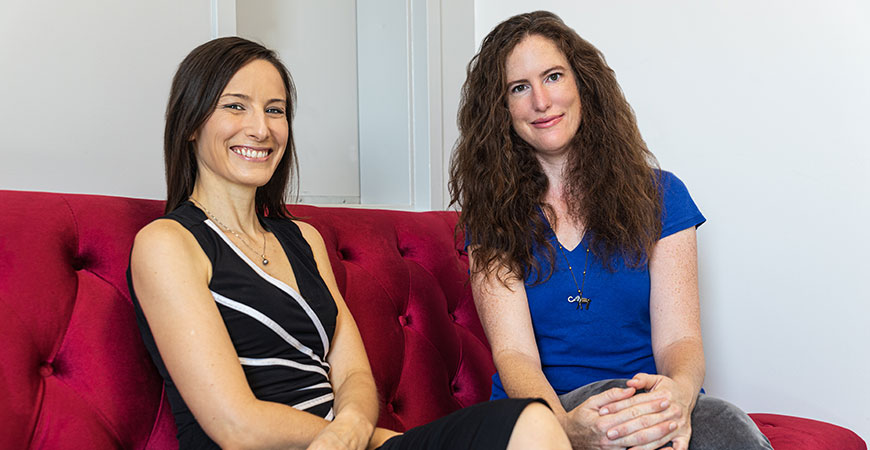
Dark matter and the life cycles of star clusters will come into focus as UC Merced’s astrophysicists get resources from the two space telescopes soon to be exploring the universe.
NASA has granted Professor Anna Nierenberg observational time with the new James Webb Space Telescope (JWST) when it’s launched this year, and Professor Sarah Loebman’s grant provides resources to analyze theoretical data that supports archival observations from the Hubble Space Telescope (HST). Loebman also received a grant from the National Science Foundation (NSF) to study spiral arms in galaxies and their connection to the life cycles of star clusters, where stars like our sun are born.
“Matter bends space/time. If there’s enough matter, you get what’s called gravitational lensing, and you can see it,” Nierenberg explained. “I use that phenomenon to learn about dark matter — by using the light that is distorted by dark matter.”
She plans to use her time with the JWST in its first year of operation to measure the properties of dark matter with these gravitational lenses.
The JWST is an orbiting infrared observatory that will complement and extend the discoveries of the HST, with longer wavelength coverage and greatly improved sensitivity, NASA said. The longer wavelengths enable JWST to look much closer to the beginning of time and hunt for the unobserved formation of the first galaxies, as well as peering inside dust clouds where stars and planetary systems are forming today. JWST will be the premier space observatory for astronomers worldwide, the space agency said.
JWST will be the first telescope to look into infrared wavelengths with high spatial resolution imaging, which is only possible because of its large mirror and the fact that it will be in orbit far from Earth. The ability to see into the infrared makes it possible to measure tiny fluctuations in gravitational lenses caused by dark matter structures, which Nierenberg will use to test dark matter models.
“JWST looks further into the infrared wavelengths and will let us get much finer detail in our observations,” Nierenberg said. “No facility on Earth can do this.”
“Dark matter potentially explains everything, but we don’t have a dark matter particle hitting a detector, and there will always be a question mark in our minds until we have confirmation like that.”
In past observations, Nierenberg has used what’s called the “narrow-emission technique” to collect lensing samples and has gathered eight. But her time on the JWST will allow her to gather 31.
“I hope this is going to be a legacy dark-matter project,” she said. Besides the observational time, the grant provides her with resources to analyze the data and support a postdoctoral researcher and a graduate student to help her do the work.
“We have to be thoughtful about how we interpret our data as our lensing signal comes from the relatively rare coincidence of a supermassive black hole radiating huge amounts of energy and a massive foreground galaxy,” she said.
What she’s ultimately looking for is proof of completely “dark matter halos,” and if she can find that, she’d have definitive proof of dark matter, she said.
“Dark matter potentially explains everything, but we don’t have a dark matter particle hitting a detector, and there will always be a question mark in our minds until we have confirmation like that,” Nierenberg said. “The detection of the existence of structures made entirely of dark matter from their effects on gravitational lenses would potentially be the smoking gun we are looking for.”
Grants for time with the space telescopes is highly competitive — people from all over the world apply, and only about one in 10 of them succeed, which makes these two grants a point of pride for the Department of Physics at UC Merced. While Nierenberg will use her time for direct observations, Loebman’s work is computational and complementary to such observations.
Loebman’s $60,000 NASA grant allows her to analyze data from the HST to help her learn more about the clusters where stars are born.
“We think most stars form in these open clusters and spread out over time,” Loebman said. “There is evidence that our sun formed in this sort of environment and could have solar siblings.”
There are many star clusters throughout the galaxy and in the nearby universe, but pictures only capture single moments in time. Through simulations, Loebman and her students can track star clusters over time and “turn on” different kinds of physics, such as magneto hydrodynamics, to impose different conditions.
“Our simulations help us see how time and environment affects where the clusters form and how this in turn shapes galaxies as they evolve,” she explained. “We have some good interpretations of current pictures, but simulations can show where the clusters form and how that is impacted by the varying conditions in the simulations.”
With the $500,000 grant from the NSF, Loebman and her lab will work on detecting where spiral structures are forming in the nearby universe and try to gain more understanding of how spiral structures and star clusters affect each other.
“I’m really excited about this because we’ll have graduate and undergraduate students working with us through a collaboration with Bryn Mawr College, a women’s college,” she said. “The students will help us make pictures of these star clusters.”
Both she and Nierenberg are interested in the building blocks, content and evolution of galaxies. The work she and the students will do helps set her lab up to track star clusters forward in time as they mix into galactic disks.
“I think this is the beginning of some great work at UC Merced,” Loebman said.



